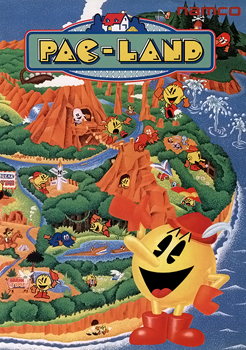Pac-Land
The digital 80's
I loved games, and in my infancy I used to be an "adult playing observer", passing hours watching people inserting 25 peseta coins for additional lifespan in Gauntlet, or trying to consume all Out Run's in-game melodies and the colorful USA-wide scroll. Defender, Space Invaders, Galaxian or Donkey Kong are the first ones I remember, full of charm, in bars, mini-golf resources, or swimming pools near León, with a delicious smell to tapas.
Pac-Land (パックランド) is an entry in the Pac-Man series of arcade video games, released into arcades by Namco, and its American distributor Bally Midway (now Midway Games), in 1984. It was the first Namco arcade game to use the then-new arcade system later titled as Namco Pac-Land Pac-Land features parallax scrolling for some of the background elements, a feature that would not become commonplace until the 16-bit console era began much later.
In the Japanese release by Namco, the Pac-Man sprite resembles the official artwork of the character with a longer nose, Pac-Man shaped eyes, and (for this game) a feathercap. In the American release of Pac-Land by Bally Midway, the characters' appearances are based on the designs from the Pac-Man animated series produced by Hanna-Barbera (which also plays the same music from the show), to promote the animated series, as well as the video game series. In addition, both versions feature the main BGM and "jingles" from the aforementioned series. Midway's version also features faster game play than Namco's. All of the ports to home consoles released inside and outside of Japan are based on Namco's version of the game.
Pac-Land itself is split into trips. In each of these trips the objective is to get the fairy (that is kept under Pac-man's hat) to Fairyland and also to return home to Pac-Man's house. The majority of the trip involves moving from left to right avoiding various obstacles such as the enemy ghosts, water spurts and quicksand traps. Each trip is divided into a number of rounds, the end of which provides Pac-Man with bonus points depending on how much time he has left and also his position in jumping at the end of each round. If the player runs out of time before finishing the round, the purple ghost will speed up rapidly.
Keywords:
3-Demon
Amiga
Amstrad CPC
Arcade game
Arcade system board
Atari Lynx
Atari ST
Baby Pac-Man
Background music
Commodore 64
Computing platform
Galaxian
Goroawase
Hanna-Barbera
History of video game consoles (fourth generation)
Jr. Pac-Man
Killer List of Videogames
List of Pac-Man clones
List of Pac-Man video games
MSX
Midway Games
MobyGames
Mr. & Mrs. Pac-Man
Ms. Pac-Man
Ms. Pac-Man Maze Madness
Namco
Namco (plug-n-play game)
Namco Museum
Namco Museum Battle Collection
Namco Museum Remix
Namco Pac-Land
Nintendo Entertainment System
Pac & Pal
Pac 'n Roll
Pac-Attack
Pac-In-Time
Pac-Land
Pac-Man
Pac-Man & Galaga Dimensions
Pac-Man (Atari 2600)
Pac-Man (TV series)
Pac-Man (character)
Pac-Man (series)
Pac-Man Anniversary Arcade Machines
Pac-Man Arrangement
Pac-Man Battle Royale
Pac-Man Championship Edition
Pac-Man Championship Edition DX
Pac-Man Collection
Pac-Man Fever (song)
Pac-Man Fever (video game)
Pac-Man Games
Pac-Man Party
Pac-Man Pinball Advance
Pac-Man Plus
Pac-Man VR
Pac-Man Vs.
Pac-Man World
Pac-Man World 2
Pac-Man World 3
Pac-Man World Rally
Pac-Mania
Pac-Pix
Parallax scrolling
Platform game
PlayStation
Professor Pac-Man
Raster graphics
Super Pac-Man
TurboGrafx-16
Video arcade
Video game
Video game developer
Video game genres
Video game publisher
World of Spectrum
ZX Spectrum
Content extracted from Wikipedia, where you can find its license details.
Ignacio Javier Gómez Rodríguez (igjav). OS developer. Naive power.

